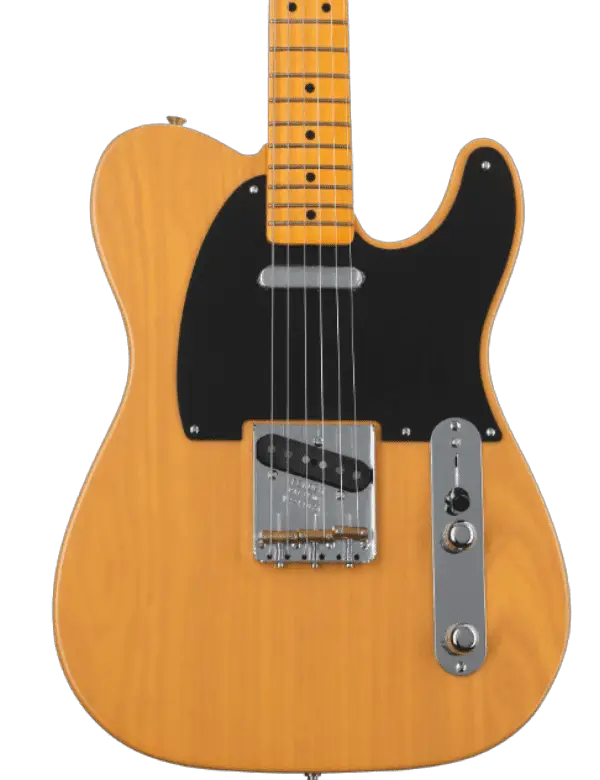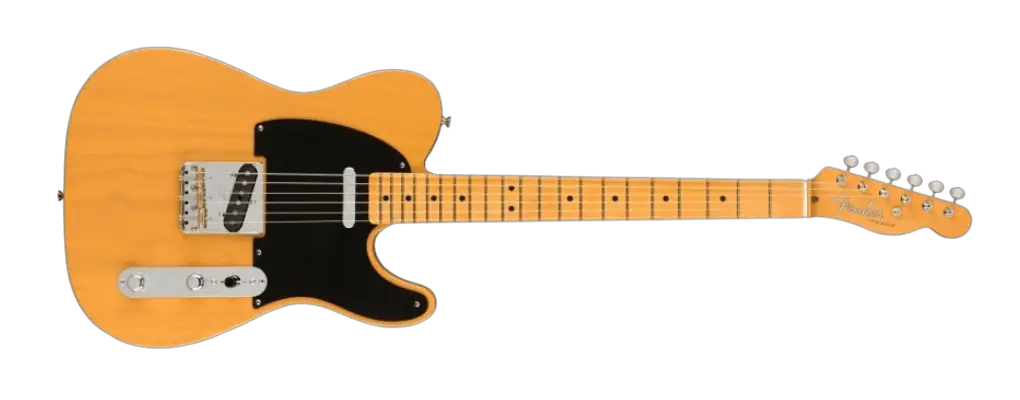American Vintage II 1951 Telecaster
The Fender American Vintage II 1951 Telecaster is an amazing re-creation of the ’51 Tele, which was the first electric guitar invention to roll off Fender’s assembly line enduring the “Telecaster” name. It is built from a slab of solid embers, this axe delivers an amazing, sustaining acoustic tone, and it complements a set of year-specific Pure Vintage ’51 Telecaster single-coil pickups. You’ll fly away by the substantial playability of the ’51 Telecaster’s “U”-shaped hard-rock maple neck, while its vintage-radius fingerboard that gives inspiring, comfortable fretting. The American Vintage II 1951 Tele is chock-full of period-correct appointments, it also includes knurled dome knobs, a 3-barrel bridge, vintage-style tuning machines, and an eye-catching nitrocellulose lacquer finish on the body and neck. The American Vintage II 1951 Telecaster has become a way to represent an important piece of Fender history — it’s a must-have for every Tele connoisseur. The instruments which are used in the American Vintage II series are direct descendants of the original Fenders: created for players with a fine appreciation for vintage Fender tone and feel and built with amazing quality, down to the last screw. It is a Fender electrics in its purest form: Fender American Vintage II considered the stuff of legendary people.
The classic and unique combination

The American Vintage II 1951 Telecaster is one of the classic and unique re-creations. This electric guitar has the features of a solid embers body. The long-lasting wood of this telecaster offers a bright amazing tone with excellent sustainability and loads of midrange “pop,” and it also boasts a flawless gloss nitrocellulose lacquer finish. The 1951 Tele’s nickel/chrome hardware has a 3-barrel bridge with brass saddles, vintage-style tuning machines, and knurled dome knobs. This Year-specific ‘1951 Pure Vintage pickups, a period-correct neck shape, and a vintage-radius fingerboard round out the American Vintage II 1951 Telecaster’s classic appointments.
The amazing quality of Year-specific Pure Vintage pickups
When you connect the Fender American Vintage II 1951 Telecaster to your favorite amplifier, you’ll be transported straight back to ‘1951 and this is one of amazing quality. This solid-body electric guitar’s Pure Vintage ’51 Telecaster single-coil pickups churn out the tight lows and balanced mids you’d expect from an old-school Tele. And its bridge pickup twangs like it’s only its business. The American Vintage II 1951 Tele comes complete with amazing master volume and tone knobs, and also a 3-way pickup selector switch.
Significant playable neck

The ’51 Tele’s 1-piece has a “U”-shaped, solid-rock maple neck and offers thick, concise, and resonant dimensions for a hand-filling playing experience. You also get a maple fingerboard with a classic 7.25-inch radius and 21 vintage-tall frets.
Characteristics of Fender American Vintage II 1951 Telecaster Electric Guitar :

- A spot-on re-creation of a 1951 Telecaster
- It has a Solid ash body that offers a bright acoustic tone with excellent sustain and loads of midrange “pop”
- You will get jangly, smooth, sparkling tones with a distinct twangy bite by Pure Vintage ‘51 Telecaster single coil pickups
- There are a knurled dome master volume and tone knobs; a 3-way pickup selector switch in the vintage telecaster
- 1-piece, “U”-shaped hard-rock maple necks will make you feel a hand-filling playing experience
- It has a vintage, 7.25-inch radius and 21 vintage-tall frets maple fingerboard
- Vintage-style tuning machines have brass saddles and 3 barrel bridge
- This telecaster has an Eye-catching nitrocellulose lacquer finish on the body and neck
Technical Specifications of American Vintage II Telecaster
- The body material of the vintage telecaster is made up of Ash
- Its Body Finish is gloss Nitrocellulose Lacquer
The Body structure of The Telecaster Guitar
- It has Neck Material 1-Piece Maple,
- Neck Construction 4-Bolt
- Neck Finish Gloss Nitrocellulose Lacquer
- Neck Shape 1951 “U”
- Scale Length 25.5″ (64.77 cm)
- Fingerboard Material Maple
- Fingerboard Radius 7.25″ (184.1 mm)
- Number of Frets 21
- Fret Size Vintage Tall
- Nut Material Bone
- Nut Width 1.650″ (42 mm)
- Position Inlays Black Dot
- Side Dots Black
- Truss Rod Vintage-Style Butt Adjust
- Truss Rod Nut Vintage-Style Butt Adjust
- Bridge Pickup Pure Vintage ’51 Single-Coil Tele
- Neck Pickup Pure Vintage ’51 Single-Coil Tele
- Controls Master Volume, Master Tone
Switching 3 position blades:
- Position1. Bridge Pickup
- Position2. Bridge and neck pickups
- Position3. Neck Pickup
Configuration SS
- Bridge Pure Vintage has 3-Saddle Tele with Brass Barrel Saddles, Serialized
- Hardware Finish Nickel/Chrome
- Tuning Machines with the pure vintage single-line “Fender Deluxe”
- Pickguard 1-Ply Black Phenolic
- Control Knobs Knurled Dome
- Switch Tip Barrel Style, Black
- Neck Plate 4-Bolt
- Bridge Cover/Tailpiece Includes Chrome Bridge Cover
- Case/Gig Bag Vintage-Style Tweed (Crushed Red Interior)
- 7 lbs 10 oz
Hand Size Comfortability
After checking the neck profile, scale size, fretboard radius, and nut width, we can easily conclude that the Fender American Vintage II 1951 Telecaster’s construction favors people with relatively big hands.
Nevertheless, this comes down in the end to personal best preference. Just give a trial to this guitar—or another one with similar characteristics—before buying.
Scale Length
Scale length is the distance whose strings will span between the bridge and the nut. It helps you a lot in knowing about the overall playability and tone of the instrument. A longer scale length means a longer distance between frets, a brighter tone, and more string tension—which means lower action, but more difficult string bending.
This is the same scale length that is used in Stratocaster guitars, and the main reason that they have such a commendable sound. It’s considered one of the long scales when compared to most non-baritone guitars.
Since the distance between the bridge and the nut is relatively long, you’ll need to give the strings more tension to get them in tune. This higher tension allows for a couple of things. First, you can get a lower action (get the strings closer to the fretboard) because the strings won’t ‘wiggle’ too much when plucked and won’t cause fret buzz. However, the frets will also have a wider separation from each other, which can make it harder to play, especially if you got small hands. The higher tension can also make the strings feel stiffer, so bending will require more strength.
Fretboard Radius
When it comes to fingerboard radius, personal preference will help you to choose which one is better for you. However, most people seem to agree that a more bend (lower) radius will make it easier to play chords while a less curved (higher) radius is better for soloing and bending.
The Fender American Vintage II 1951 Telecaster has a fingerboard whose radius is 7.25″. Here’s an image comparing this guitar’s fretboard radius to other popular choices: This type of radius is considered vintage because it’s a lot shorter than what is used in modern guitars. However, this comes at a disadvantage. Bending the strings will be more difficult because you will have to adapt your bends to the bend. Also, you won’t be able to set the action of the strings low because your strings will ”fret out” and get muted when bending due to the curve making the string hit the other frets. Compound radius fingerboards give the best of both worlds. But, the Fender American Vintage II 1951 Telecaster has the same radius across the board.
Nut Width
The Fender Telecaster has a nut width of 41.9mm (1.65”). This is smaller than the typical 43mm (1 11/16″) found in electric guitars. It means that this guitar will have a small string separation at the nut, which will affect your fretting hand.
If you have big hands, you may face difficulty to play chords without muting strings. However, this is good for players who have little hands, as it will allow them to reach each string much easier at the nut.
Frets
The Fender Vintage II 1951 Telecaster has 21 frets. Although 24 frets have become popular, there are still so many good reasons to get fewer frets; the pickup at the neck position will be further away from the bridge. However, if you don’t care about the little warmer neck pickup, then more frets will always be better. It’s always good to have the option to play higher notes if you want to.
Finally, these are nickel silver frets, that’s why they won’t last as long as stainless steel frets. If you use your instrument a lot, so the frets will have to be replaced after a few years.
Fret Size
Finally, let’s talk about fret size. Some people have priority over tall frets because it’s easier to press the strings and perform bends since there’s less friction against the fretboard. However, this size usually means that the crown width is narrower than most modern frets, but the height is a little bit taller than the usual vintage fret. You should take a feel of the fretboard when playing with these frets, but they’re not as hard to press as real vintage frets.
Does the Sound of Fender American Vintage II 1951 Telecaster Good? Tone Analysis
Wood may little influence the final tone of an electric guitar. Instead, let’s look at the hardware used—mainly the pickups—to determine what kind of tone you can expect.
Pickups
This guitar comes with amazing pickups from one of the top brands: Fender. So you can easily expect well-built pickups with great sound that shouldn’t need an upgrade anytime soon.
These are passive pickups, so you can expect a good level of hot output instead of the overwhelming output that distinguishes active pickups in metal.
This is the vintage Telecaster configuration which is used mainly for playing clean or with low-gain distortion.
Versatility
It has the popular 3-way switch that is present in most guitars. To become more versatile, guitarists tend to prefer a 5-way switch, although it all depends on what you want to use your guitar for. But unluckily, it doesn’t come with more options for coil split or coil tapping. This makes it a little bit less versatile than some competitors.
Quality of Wood Which is Used in the Fender American Vintage II 1951 Telecaster
As an electric guitar, wood won’t affect the tone and sustain much. However, wood is still a necessary thing for the look and feel of the guitar in general. These are the types of wood that are used in the Fender American Vintage II 1951 Telecaster:
The fretboard and neck are made of Maple. This is the most popular type of wood used in all kinds of guitars. It’s bulky, strong, and compact, which makes it great for necks. Finally, the body material is Ember.
**also read**
Gibson g-bird guitar review
Bridge
The bridge is an ultimate pure Vintage 3-Saddle Tele with Brass Barrel Saddles, Serialized. The advantage of fixed bridges is that it doesn’t require any kind of setup. This makes it extremely easy because you don’t need to adjust anything besides tuning the guitar. Also, the fact that the bridge is directly connected to the body will help to increase sustain. The issue is the lack of versatility since you can’t create the same vibrato effects as with tremolo bridges.
Nut Material
There is also another important thing to analyze is the nut material, as it’s one of the most important aspects that can affect the sound and playability of your guitar. A well-cut nut makes sure the guitar stays in tune and will make it more comfortable to play. There are two different bone nuts, even if made from the same bone, which will probably sound slightly different. However, keep in mind that this is only relevant when playing open strings.
Neck Joint
There are overall three main techniques to attach both parts: Fit-in, Bolt-On, and Neck-Through. The other two provide different advantages, although neck-throughs are the most expensive.
This guitar has a Bolt-On neck joint. Although this type of neck was looked down upon for a long time, nowadays bolt-on necks are well-designed and provide just as much sustain as any other joint method. First of all, it’s the least expensive to make because it consists of simply 4 bolts that attach the neck to the body. And you can travel with the guitar easily, take out the neck if you damage it, or upgrade to a more comfortable neck later on.
Where & How well is the Fender American Vintage II 1951 Telecaster Designed?
Knowing where the guitar is produced can be proven a good way to know how well it’s built. Some manufacturing countries are very well known for having higher quality standards. The Fender American Vintage II 1951 Telecaster is designed in the United States. Guitars made in the USA have the reputation of becoming the best instruments you can get.
Is Fender American Vintage II 1951 Telecaster Easy to Play?
The Fender American Vintage II 1951 Telecaster has 6 out of our 8 criteria items which are beginner friendliness, which means that it’s a good guitar to start with as a complete fresher. This is the type of frets, scale length, nut width, bridge type, fretboard radius, and neck profile to determine the best combination for new players to get used to.





